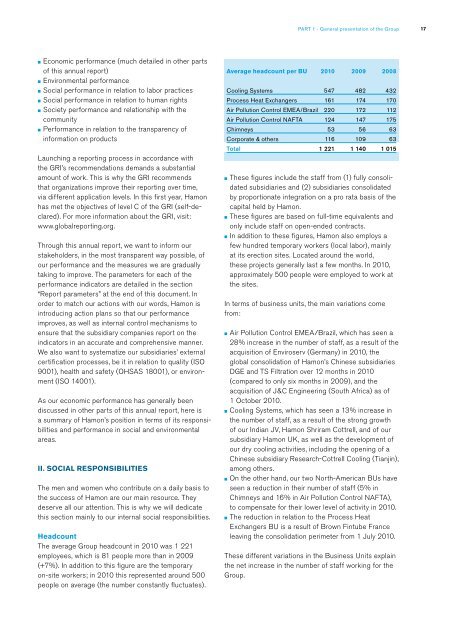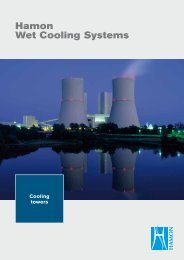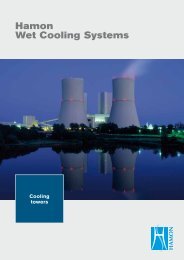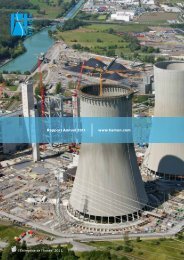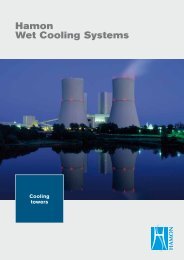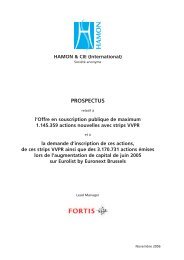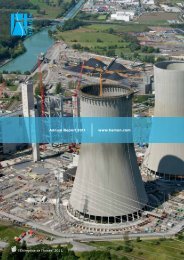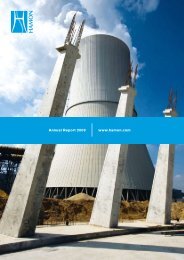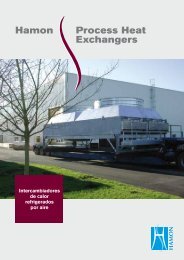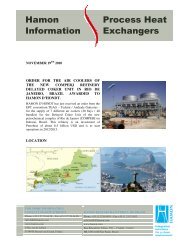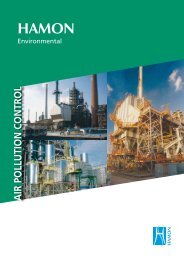Download PDF version English(2664KB) - Hamon
Download PDF version English(2664KB) - Hamon
Download PDF version English(2664KB) - Hamon
You also want an ePaper? Increase the reach of your titles
YUMPU automatically turns print PDFs into web optimized ePapers that Google loves.
Part 1 - General presentation of the Group<br />
17<br />
■ Economic performance (much detailed in other parts<br />
of this annual report)<br />
■ Environmental performance<br />
■ Social performance in relation to labor practices<br />
■ Social performance in relation to human rights<br />
■ Society performance and relationship with the<br />
community<br />
■ Performance in relation to the transparency of<br />
information on products<br />
Launching a reporting process in accordance with<br />
the GRI’s recommendations demands a substantial<br />
amount of work. This is why the GRI recommends<br />
that organizations improve their reporting over time,<br />
via different application levels. In this first year, <strong>Hamon</strong><br />
has met the objectives of level C of the GRI (self-declared).<br />
For more information about the GRI, visit:<br />
www.globalreporting.org.<br />
Through this annual report, we want to inform our<br />
stakeholders, in the most transparent way possible, of<br />
our performance and the measures we are gradually<br />
taking to improve. The parameters for each of the<br />
performance indicators are detailed in the section<br />
“Report parameters” at the end of this document. In<br />
order to match our actions with our words, <strong>Hamon</strong> is<br />
introducing action plans so that our performance<br />
improves, as well as internal control mechanisms to<br />
ensure that the subsidiary companies report on the<br />
indicators in an accurate and comprehensive manner.<br />
We also want to systematize our subsidiaries’ external<br />
certification processes, be it in relation to quality (ISO<br />
9001), health and safety (OHSAS 18001), or environment<br />
(ISO 14001).<br />
As our economic performance has generally been<br />
discussed in other parts of this annual report, here is<br />
a summary of <strong>Hamon</strong>’s position in terms of its responsibilities<br />
and performance in social and environmental<br />
areas.<br />
II. Social responsibilities<br />
The men and women who contribute on a daily basis to<br />
the success of <strong>Hamon</strong> are our main resource. They<br />
deserve all our attention. This is why we will dedicate<br />
this section mainly to our internal social responsibilities.<br />
Headcount<br />
The average Group headcount in 2010 was 1 221<br />
employees, which is 81 people more than in 2009<br />
(+7%). In addition to this figure are the temporary<br />
on-site workers; in 2010 this represented around 500<br />
people on average (the number constantly fluctuates).<br />
Average headcount per BU 2010 2009 2008<br />
Cooling Systems 547 482 432<br />
Process Heat Exchangers 161 174 170<br />
Air Pollution Control EMEA/Brazil 220 172 112<br />
Air Pollution Control NAFTA 124 147 175<br />
Chimneys 53 56 63<br />
Corporate & others 116 109 63<br />
Total 1 221 1 140 1 015<br />
■ These figures include the staff from (1) fully consolidated<br />
subsidiaries and (2) subsidiaries consolidated<br />
by proportionate integration on a pro rata basis of the<br />
capital held by <strong>Hamon</strong>.<br />
■ These figures are based on full-time equivalents and<br />
only include staff on open-ended contracts.<br />
■ In addition to these figures, <strong>Hamon</strong> also employs a<br />
few hundred temporary workers (local labor), mainly<br />
at its erection sites. Located around the world,<br />
these projects generally last a few months. In 2010,<br />
approximately 500 people were employed to work at<br />
the sites.<br />
In terms of business units, the main variations come<br />
from:<br />
■ Air Pollution Control EMEA/Brazil, which has seen a<br />
28% increase in the number of staff, as a result of the<br />
acquisition of Enviroserv (Germany) in 2010, the<br />
global consolidation of <strong>Hamon</strong>’s Chinese subsidiaries<br />
DGE and TS Filtration over 12 months in 2010<br />
(compared to only six months in 2009), and the<br />
acquisition of J&C Engineering (South Africa) as of<br />
1 October 2010.<br />
■ Cooling Systems, which has seen a 13% increase in<br />
the number of staff, as a result of the strong growth<br />
of our Indian JV, <strong>Hamon</strong> Shriram Cottrell, and of our<br />
subsidiary <strong>Hamon</strong> UK, as well as the development of<br />
our dry cooling activities, including the opening of a<br />
Chinese subsidiary Research-Cottrell Cooling (Tianjin),<br />
among others.<br />
■ On the other hand, our two North-American BUs have<br />
seen a reduction in their number of staff (5% in<br />
Chimneys and 16% in Air Pollution Control NAFTA),<br />
to compensate for their lower level of activity in 2010.<br />
■ The reduction in relation to the Process Heat<br />
Exchangers BU is a result of Brown Fintube France<br />
leaving the consolidation perimeter from 1 July 2010.<br />
These different variations in the Business Units explain<br />
the net increase in the number of staff working for the<br />
Group.


